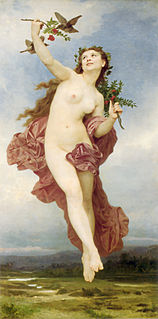 W
WA day is approximately the period of time during which the Earth completes one rotation around its axis. A solar day is the length of time which elapses between the Sun reaching its highest point in the sky two consecutive times. Days on other planets are defined similarly and vary in length due to differing rotation periods, that of Mars being slightly longer and sometimes called a sol.
 W
WDagr is the divine personification of the day in Norse mythology. He appears in the Poetic Edda, compiled in the 13th century from earlier traditional sources, and the Prose Edda, written in the 13th century by Snorri Sturluson. In both sources, Dagr is stated to be the son of the god Dellingr and is associated with the bright-maned horse Skinfaxi, who "draw[s] day to mankind". Depending on manuscript variation, the Prose Edda adds that Dagr is either Dellingr's son by Nótt, the personified night, or Jörð, the personified Earth. Otherwise, Dagr appears as a common noun simply meaning "day" throughout Old Norse works. Connections have been proposed between Dagr and other similarly named figures in Germanic mythology.
 W
WDies was the personification of day Roman mythology, and the counterpart of the Greek goddess Hemera, the daughter of Nox (Night) and Scotus (Darkness).
 W
WA diurnal cycle is any pattern that recurs every 24 hours as a result of one full rotation of the Earth around its own axis.
 W
WDiurnality is a form of plant or animal behavior characterized by activity during daytime, with a period of sleeping or other inactivity at night. The common adjective used for daytime activity is "diurnal". The timing of activity by an animal depends on a variety of environmental factors such as the temperature, the ability to gather food by sight, the risk of predation, and the time of year. Diurnality is a cycle of activity within a 24-hour period; cyclic activities called circadian rhythms are endogenous cycles not dependent on external cues or environmental factors except for a zeitgeber. Animals active during twilight are crepuscular, those active during the night are nocturnal, and animals active at sporadic times during both night and day are cathemeral.
 W
WIn Greek mythology Hemera was the personification of day and one of the Greek primordial deities. She is the goddess of the daytime and, according to Hesiod, the daughter of Erebus and Nyx.
 W
WSolar time is a calculation of the passage of time based on the position of the Sun in the sky. The fundamental unit of solar time is the day. Two types of solar times are apparent solar time and mean solar time.